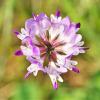Lavender (Lavandula Angustifolia) is a plant from southern Europe and belongs to the mint family (Lamiaceae). The blossom of the lavender bush smells of freshly picked herbs and flowers simultaneously. This scent is particularly well-suited to rose and citrus scents and, most notably, men's fragrances.
Lavender is often called a jack of all trades because this plant smells lovely and can have healing properties. The aroma of lavender oil predominantly has a calming and relaxing effect on the nerves, and it is even used as a remedy. In addition, the aroma of lavender oil has an anti-spasmodic, mood-enhancing effect and is prescribed in the context of aromatherapy for stress, migraines, and sleep disorders.
Lavandula Angustifolia Oil is widely used because of its many benefits and uses, including anti-inflammatory and calming properties that have a balancing effect for many skin conditions. It has a fresh, clean scent.
Lavender oil is an all-purpose skincare oil that relieves pain, promotes healing, and prevents scarring by stimulating the cells to regenerate more quickly. It is used on itchy skin, bruises, burns, and blemishes.Lavandula Angustifolia Oil stimulates microcirculation, improves cell metabolism, and promotes healthy tissue growth. Lavender has powerful antibacterial properties and protects skin from harmful bacteria. Its benefits are immediate, as it is absorbed rapidly by the skin. It works well in the bath to act on the skin and enhances the therapeutic and feel-good factor of body or face moisturizers.












